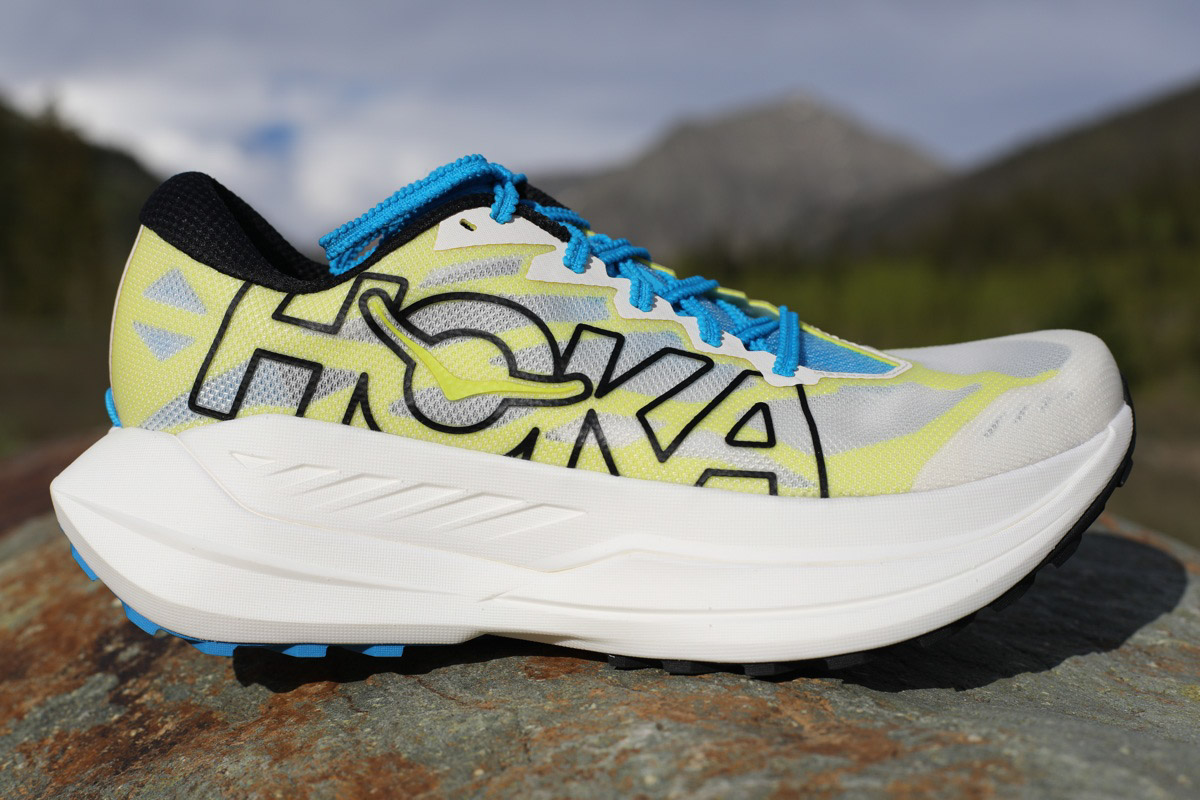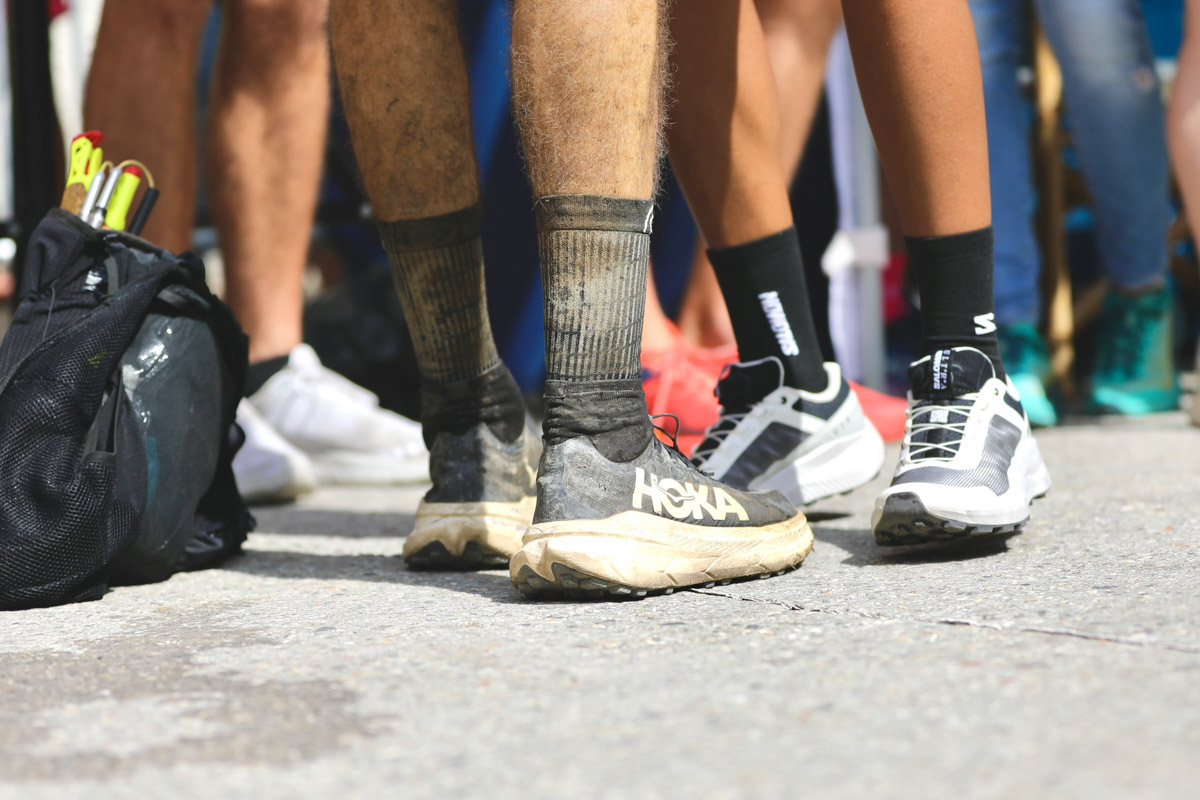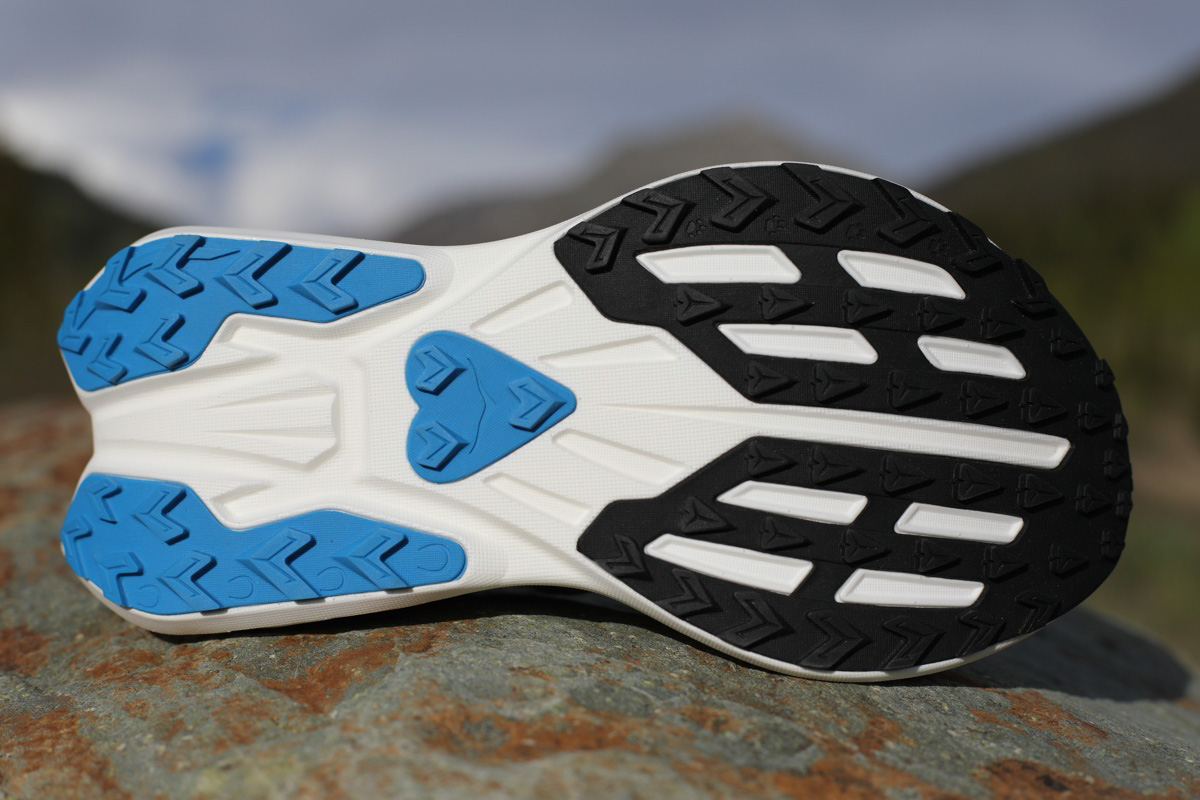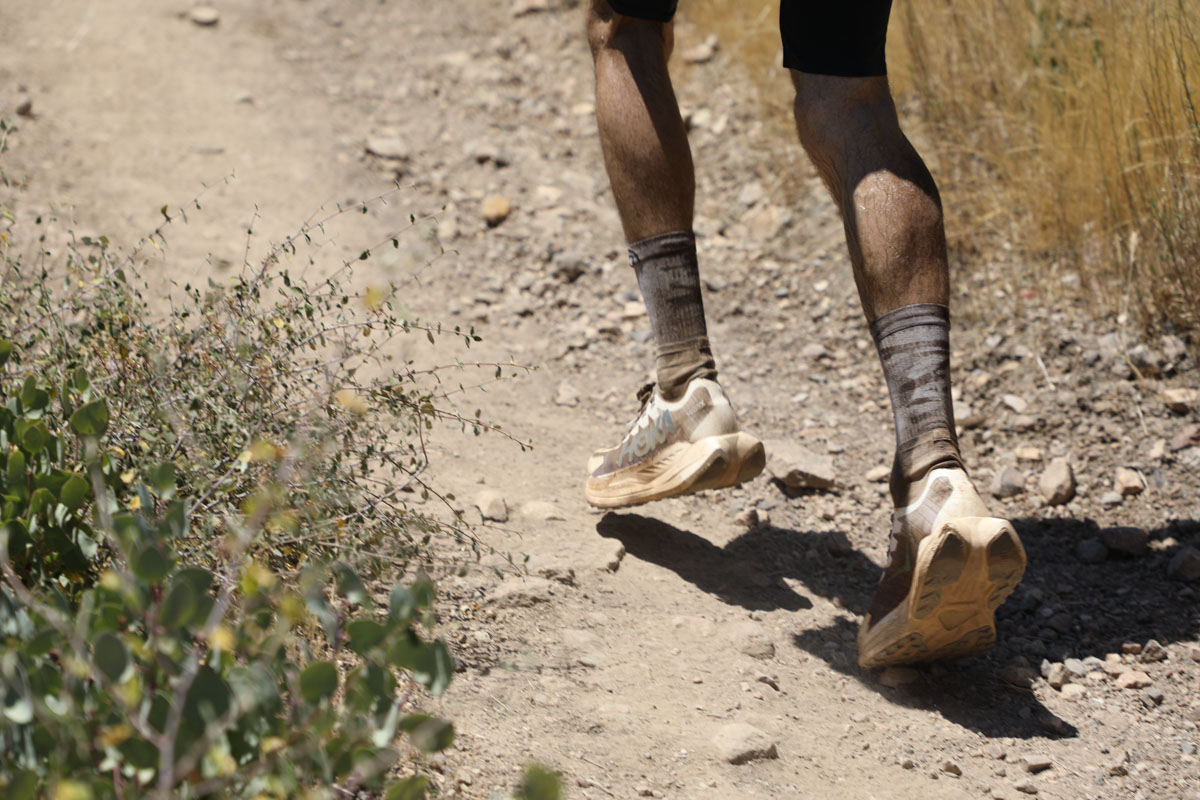When Hoka first introduced maximally cushioned shoes circa 2009 to a running market trending toward minimalism, many sat back, popcorn in hand, to watch what would come of these new shoes with their wild stack heights. Well, we all know where that storyline went. Now, the brand is in a boom phase for its carbon plate trail running shoes, and once again, we’re enjoying the show.
Until a few months ago, the Tecton X line, currently in its third iteration, was the single model of trail shoes Hoka had in its lineup that featured a carbon plate. Then, just last month, Hoka debuted the Mafate X, a totally different species of carbon trail shoe. If the Tecton X line excels on medium-difficulty trails, then the Mafate X line is a carbon tank, meant to bully its way through anything the trail presents.
Over the last year, however, Hoka aficionados have noticed whisperings of something else brewing in the brand’s carbon plate trail shoe program. We saw unique features on the custom shoes Hoka athlete Ludovic Pommeret wore to win the 2024 and 2025 Hardrock 100 and take fifth place at the 2024 UTMB. We saw similar details in the custom shoes Vincent Bouillard wore to win the 2024 UTMB and on his tough DNF at the 2025 Western States 100. And we saw the same features in the shoes of Fu-Zhao Xiang when she took second at the 2025 Western States 100.
Now, we finally know this shoe to be the Hoka Rocket X Trail, the brand’s not-yet-released third carbon plate trail model.

As early as the 2024 Hardrock 100, rumors swirled about what shoe Hoka athlete Ludovic Pommeret was wearing. He told iRunFar in 2025 that his custom shoes use the midsole from the Hoka Rocket X Trail. Photo: iRunFar/Eszter Horanyi
Having now put 120 miles and counting on our own pair, we can confirm this shoe is designed for pure speed on gravel and non-technical singletrack. An H-shaped carbon plate, exotic Aliphatic TPU foam, a pretty aggressive rocker, and low-profile lugs that still provide enough grip combine to create quite the shoe. At the same time it’s built on a couple of concepts from its predecessors on both the trail and road side of the brand, as well as a wild science experiment containing features not yet seen in trail shoes. As we said, what a show this will be.

The carbon-plated Hoka Rocket X Trail. A science experiment in trail shoes. Photo: iRunFar/Bryon Powell
Hoka Rocket X Trail Basic Specifications
Let’s take a look at the specifics of the Hoka Rocket X Trail:
- Actual Weight: 9.1 ounces (258 grams) for U.S. men’s 9
- Drop: 6 millimeters
- Stack Height: 42 millimeters at the heel/36 millimeters at the toe for U.S. men’s 10
- Upper Material: Lightweight single-layer mesh with thin TPU underlays
- Tongue: Regular, minimal
- Midsole: Two layers of Aliphatic TPU foam that sandwich an H-shaped carbon plate
- Outsole: Zoned rubber
- Lugs: 3.5 millimeters
- Release Date: Fall 2025
- Price: $250

Hoka athlete Fu-Zhao Xiang opted for the Hoka Rocket X Trail during part of her second-place run at the 2025 Western States 100. Photo: iRunFar/Eszter Horanyi
Hoka Rocket X Trail Special Features
The Hoka Rocket X Trail isn’t a shoe for easy runs or walking the dog. It’s also not a shoe that makes you feel confident when the trails get technical. It can feel downright awkward at slow paces and on uneven terrain, but when the pace picks up, a unique set of features combine to create a race shoe that just wants to fly over specific types of terrain. Let’s look at a couple of the special features of this shoe.
Premium Midsole Foam
If you’re following super shoe foam developments, then you know that Aliphatic TPU (A-TPU) foam is poised to challenge PEBA as the most sought-after foam for super shoes. While this foam can currently be found in a couple of other shoes on the market, this is the first time it’s being used by Hoka. And as far as we know, it’s also the first time the foam is coming to market in a trail shoe. Foam experts tell us that A-TPU is supposed to be even more responsive than PEBA, and we’ll have to agree that this shoe has just as much, if not more, pop than other super shoes we’ve worn — road or trail.
The midsole of the Hoka Rocket X Trail is tall, by trail standards, with 42 millimeters of thickness at the heel, and 36 millimeters at the toe, in a U.S. men’s 10. If you come to this shoe from the world of road super shoes, its stack height will feel right at home. But for those more used to the generally lower stack height of trail shoes, you’ll feel the difference here.

The stack height of the Hoka Rocket X Trail likely competes among the highest ever used in a commercially released trail shoe. Photo: iRunFar/Bryon Powell
The shoe wears its height well, compressing more in the heel than the forefoot, providing cushion during the initial footstrike and a firm platform for a strong toe-off. The foam also squishes out laterally when under load, offering an even larger footprint for improved stability. If the stack height is more reminiscent of road super shoes, the 6-millimeter drop stays in the range of most trail shoes.
The aggressive rocker encourages a midfoot-to-forefoot landing and an efficient toe-off, a gait that will feel more natural at the faster paces this shoe is designed for.
H-Shaped Carbon Plate
Instead of a solid carbon plate, like that used in many road super shoes, Hoka employs an H-shaped plate for the Rocket X Trail. Similar to the forked carbon plate used in the Hoka Mafate X on the trail side and Hoka Skyward X on the road side, the plate is more flexible in the lateral direction than a solid one, allowing the plate to flex and adjust to changing terrain. It’s worth noting that the Rocket X Trail’s carbon plate is different in shape from the one in the Hoka Tecton X 3, which also has additional winglets for better lateral stability.
Indeed, the Rocket X Trail feels decidedly less stable on off-camber or more technical trails than the Tecton X 3 but offers noticeably more propulsion with each step. In the end, it’s impossible to discern from where these feelings originate: the new-to-us A-TPU foam, the lofty stack height, the uniquely designed carbon plate shape, its rocker shape, or some combination of the above. However, we think others will agree that the feeling underfoot is just as unique as the shoe’s features.

Vincent Bouillard wore shoes with what looked like several Hoka Rocket X Trail features on his way to winning the 2024 UTMB. Photo: iRunFar/Meghan Hicks
Lightweight Upper with Support in the Right Places
Made of lightweight mesh, the Rocket X Trail upper is thinner and stiffer than the Matryx upper of the Tecton X 3 and more reminiscent of the uppers on some of Hoka’s carbon road shoes. Although you can see through it, the mesh is fine enough to keep most debris out.
TPU underlays provide additional structure around the foot for a decent lockdown, and the heel cup is structurally solid and well-padded to hold the heel comfortably in place. Notably, the tongue is pretty thin, so it’s imperative that it’s placed in the proper position before lacing up and tying the textured laces.
A few features distinguish this shoe from a pure road-to-trail shoe, including a reinforced toe bumper that protects from rocks. A built-in gaiter attachment point at the heel nods to the fact that even on dirt roads or non-technical trails, sometimes conditions warrant extra coverage to keep rocks and dust out of shoes, especially over longer distances.

Ludovic Pommeret wore shoes with features similar to the Hoka Rocket X Trail on his way to winning both the 2024 and 2025 Hardrock 100. Here he is during the 2025 event. Photo: iRunFar/Eszter Horanyi
Zoned Outsole
Not meant for mud, rubbly trails, or long off-camber sections, the Hoka Rocket X Trail outsole, with its zoned design and strategically placed 3.5-millimeter lugs, provides enough grip on gravel and smoother trails while saving a lot of weight compared to a full rubber outsole.
There’s significantly more tread on the front of the shoe than the heel, another vote toward the forefoot-striking stride that the shoe encourages. The small triangular lugs are more aggressive on the edges than in the middle, and the rear of the outsole uses the same lug design at the edges of the front, except placed backward to provide braking and downhill control.
With this zoned outsole design, much of the midsole is exposed, increasing the shoe’s flexibility and lowering its weight compared to the full coverage of the Tecton X 3 and other more trail-specific shoes. There is enough rubber to provide grip as long as the running surfaces are relatively flat and smooth.

The minimalist outsole of the Hoka Rocket X Trail provides enough grip for dirt roads and flat, fast trails. Photo: iRunFar/Bryon Powell
Hoka Rocket X Trail Final Thoughts
There’s no denying that the Hoka Rocket X Trail is a pure go-fast shoe. We also need to call this shoe what it is: a big ol’ science experiment for trail runners.
It has among the highest stack height in the trail shoe world, a brand new, relatively untested-on-the-trails foam, an unusual H-shaped carbon plate, and a minimalist outsole that historically would be laughed off stage in a contest of trail shoe outsoles. But, in very specific conditions — namely, dirt road routes and races that blur the line between road and trail running — this shoe is fast.
It also has features, including the protective heel collar and toe bumper, that will keep your feet happy as the miles add up.
With the shoe poised to reach the market in early fall, the science experiment that is the Rocket X Trail will be released to the masses for us all to enjoy going really fast on the dirt. Until then, we have a summer of racing where we can continue speculating about what’s on the feet of Hoka athletes.
Call for Comments
- Where else have you seen possible components of the Hoka Rocket X Trail out and about?
- Have you tried this shoe on? How does it compare to Hoka’s other carbon plate trail models for you?


